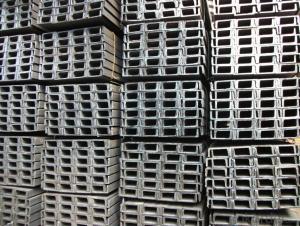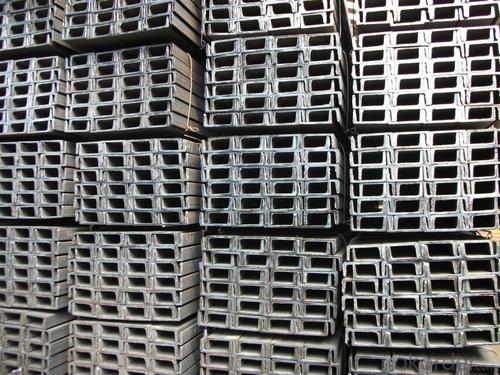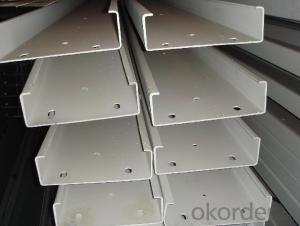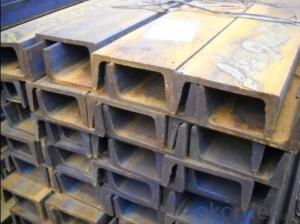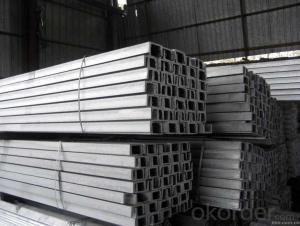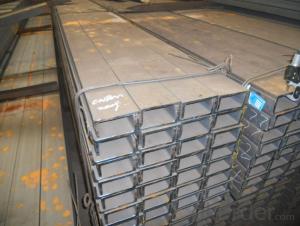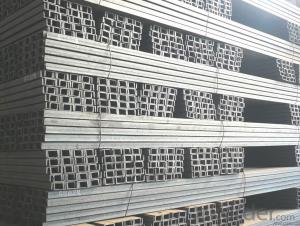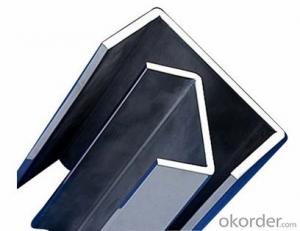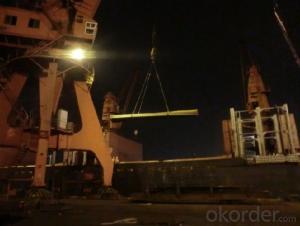New Arrival U Channel Steel to Africa Market
- Loading Port:
- Tianjin
- Payment Terms:
- TT OR LC
- Min Order Qty:
- 25 m.t.
- Supply Capability:
- 5000 m.t./month
OKorder Service Pledge
OKorder Financial Service
You Might Also Like
Specification
high quality Hot Rolled Steel U Beam at great prices with worldwide shipping. Our supplier is a world-class manufacturer of steel, with our products utilized the world over. OKorder annually supplies products to European, North American and Asian markets. We provide quotations within 24 hours of receiving an inquiry and guarantee competitive prices.
We supply high quality MS Channel at reasonable price, including Chinese standard, Japanese standard and so on.
Standard | GB/JIS |
Material Grade | Q235,SS400 |
Technique: | Hot Rolled |
Sizes as per chinese standard: | 50*37*4.5mm - 300*89*11.5mm |
Sizes as per japanese standard: | 50*25*3mm – 200*80*7.5mm |
Length: | 6meter, 9meter, 12meter |
Product Applications:
Hot Rolled Steel U-Beams are ideal for structural applications and are widely used in the construction of buildings and bridges, and the manufacturing, petrochemical, and transportation industries.
Product Advantages:
OKorder's Steel U-Beams are durable, strong, and resist corrosion.
Main Product Features:
· Premium quality
· Prompt delivery & seaworthy packing (30 days after receiving deposit)
· Corrosion resistance
· Can be recycled and reused
· Mill test certification
· Professional Service
· Competitive pricing
Product Specifications:
Manufacture: Hot rolled
Grade: Q195 – 235
Certificates: ISO, SGS, BV, CIQ
Length: 6m – 12m, as per customer request
Packaging: Export packing, nude packing, bundled
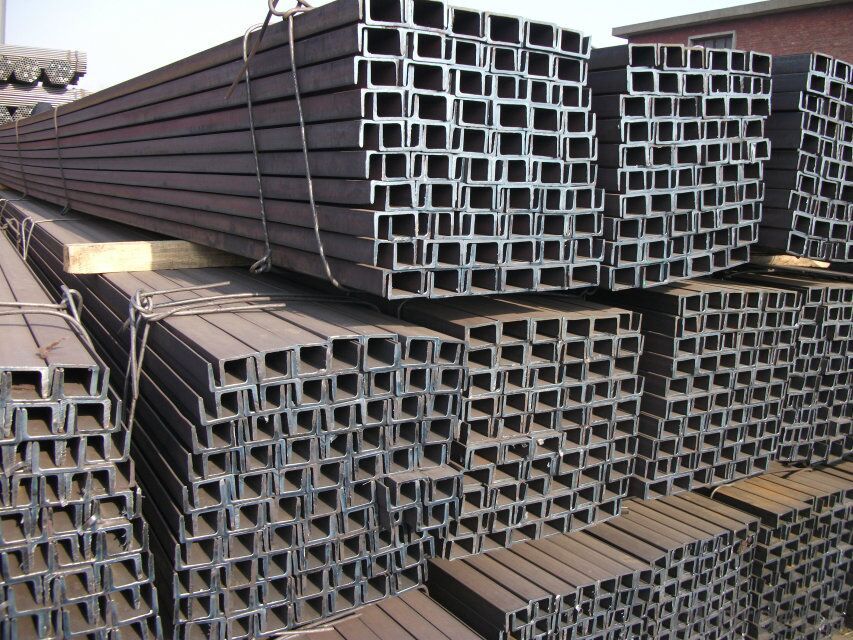

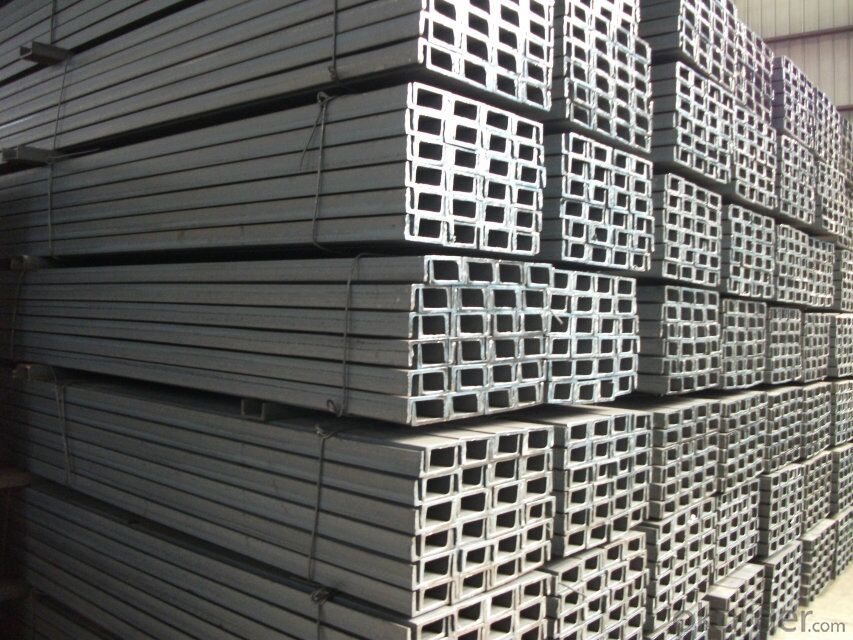
- Q: How do steel channels contribute to the versatility of a building design?
- Steel channels contribute to the versatility of a building design in several ways. Firstly, steel channels are incredibly strong and durable, allowing them to support heavy loads and withstand extreme weather conditions. This strength and durability provide architects and engineers with the freedom to create innovative and complex designs, knowing that the steel channels will provide the necessary structural support. Additionally, steel channels come in a variety of sizes and shapes, offering flexibility in design. They can be manufactured to precise specifications, allowing for customization and adaptation to fit the unique requirements of a building project. This versatility allows architects to create structures with different heights, spans, and configurations, enabling them to maximize space and create dynamic and visually appealing designs. Steel channels also offer ease of installation and assembly, simplifying the construction process. They can be easily connected using various methods such as welding, bolting, or riveting, allowing for efficient and cost-effective construction. This ease of installation ensures that building projects can be completed in a timely manner, saving both time and resources. Furthermore, steel channels are highly recyclable, making them an environmentally friendly choice for building designs. Steel can be recycled multiple times without losing its inherent properties, reducing the need for new raw materials and minimizing waste. This sustainable aspect of steel channels contributes to the overall versatility of building designs by meeting modern environmental standards and promoting eco-conscious construction practices. In summary, steel channels contribute to the versatility of building design through their strength, durability, customization options, ease of installation, and sustainability. By incorporating steel channels into building projects, architects and engineers can push the boundaries of design, create unique structures, and meet the diverse needs of clients and communities.
- Q: What are the considerations for designing steel channel connections?
- To ensure the structural integrity and safety of the overall system, several key considerations must be taken into account when designing steel channel connections. These considerations encompass: 1. Load capacity: The connection design should withstand anticipated loads and forces acting on the steel channels. This includes both static and dynamic loads, such as dead loads, live loads, wind loads, and seismic loads. 2. Connection type: Steel channels can be connected using bolted connections, welded connections, or a combination of both. The choice of connection type should be based on factors like expected loads, ease of installation, maintenance requirements, and cost-effectiveness. 3. Strength and stiffness: The connection design should provide sufficient strength and stiffness to resist applied loads without excessive deflection or deformation. This involves considering material properties like yield strength, ultimate strength, and modulus of elasticity, as well as connection details and geometry. 4. Fatigue resistance: If steel channels face cyclic or repeated loading, such as in bridges or machinery, the connection design should resist fatigue failure. This may involve incorporating features like fillet welds, reinforcement plates, or special detailing to enhance fatigue strength. 5. Alignment and fit-up: Proper alignment and fit-up of steel channels at connection points are crucial for a secure and effective connection. The connection design should account for potential misalignments or tolerances in the fabrication and erection process, and provide means for adjustment or correction if necessary. 6. Serviceability and maintenance: The connection design should consider long-term performance and durability. This includes factors like corrosion protection, accessibility for inspection and maintenance, and potential for future modifications or repairs. 7. Code compliance: The connection design should comply with relevant building codes, standards, and regulations. It is essential to consider requirements and guidelines specified by national or international codes, as well as any specific design criteria or recommendations from structural engineering associations. In conclusion, designing steel channel connections necessitates a comprehensive understanding of steel's mechanical behavior, as well as specific loading conditions and performance requirements. By considering these factors and employing appropriate design methods and principles, engineers can ensure the reliability and safety of steel channel connections in various structural applications.
- Q: Are steel channels suitable for seismic zones?
- Steel channels, also known as C-channels or U-channels, are well-suited for seismic zones. Their structural strength and flexibility make them commonly used in seismic design and construction. Steel's high strength-to-weight ratio makes it ideal for withstanding seismic forces. Furthermore, steel channels can be engineered to have the necessary stiffness and ductility to absorb and dissipate energy during an earthquake, reducing the impact of seismic shaking on the structure and making it more resilient and less prone to damage. Additionally, steel channels offer excellent fire resistance, an important consideration in seismic zones. Overall, due to their durability, flexibility, and ability to withstand seismic forces, steel channels are a popular choice for seismic design and construction.
- Q: How do you calculate the weight of 100 channel steel?
- CAD drawing can also be used to calculate the cross-sectional area of 100 channel, or other ways to first calculate the cross section area of 100 channel.
- Q: 18# channel perimeter
- Channel 18#A 180*68*7.0 theory weight 20.174, section area 25.69, channel 18#B 180*70*9.0 theory weight 23, section area 29.29, average leg thickness 10.5, inner arc radius 10.5, leg end arc radius 5.25
- Q: Can steel channels be used for HVAC duct supports?
- Indeed, HVAC duct supports can utilize steel channels. Due to their robustness and durability, steel channels prove to be an ideal choice for furnishing structural reinforcement to HVAC ducts. The installation process is hassle-free, and they furnish the ductwork with stability and rigidity. Moreover, steel channels possess the ability to sustain the weight of both the ducts and any supplementary equipment affixed to them, thereby ensuring the optimal operation of the HVAC system.
- Q: How to input the sign of channel steel in Excel
- The channel is the section for the steel strip shape groove, the specifications with the waist high (H) (b) * * legs wide waist thick (d) mm number representation, such as 100*48*5.3, said 100 mm high waist, leg width is 48 mm, 5.3 mm thick waist channel, or 10# channel.
- Q: What are the applications of steel channels in construction?
- Steel channels have a wide range of applications in construction due to their strength, durability, and versatility. Here are some of the key applications of steel channels in construction: 1. Structural Support: Steel channels are commonly used to provide structural support in buildings, bridges, and other infrastructure projects. They can be used as beams or columns to carry loads and distribute weight effectively. 2. Framing: Steel channels are often used in framing applications, especially for walls, ceilings, and roofs. They provide a strong and reliable framework, ensuring the stability and integrity of the structure. 3. Staircases and Handrails: Steel channels are ideal for constructing staircases and handrails due to their strength and rigidity. They provide a safe and durable solution, especially in high-traffic areas. 4. Reinforcement: Steel channels can be used to reinforce concrete structures, such as foundations, walls, and slabs. By adding steel channels, the strength and load-bearing capacity of the concrete are significantly increased. 5. Mezzanine Floors: Steel channels are commonly used to create mezzanine floors, which provide additional space in buildings without the need for expanding the footprint. Steel channels offer a lightweight yet sturdy solution for supporting the floor structure. 6. Industrial Racks and Shelves: Steel channels are widely used in the construction of industrial racks and shelves. Their load-bearing capacity and durability make them suitable for storing heavy equipment, materials, and products. 7. Infrastructure Projects: Steel channels find extensive applications in large-scale infrastructure projects, including bridges, tunnels, and railways. Their high strength-to-weight ratio makes them ideal for withstanding heavy loads and resisting environmental factors. 8. Architectural Design: Steel channels are often used in architectural design to create unique and aesthetically pleasing structures. They can be shaped and welded into various configurations, allowing architects to bring their creative visions to life. Overall, steel channels play a crucial role in the construction industry, offering a reliable, durable, and versatile solution for various applications. Their strength, load-bearing capacity, and flexibility make them indispensable in modern construction projects.
- Q: Can steel channels be used in modular construction?
- Yes, steel channels can be used in modular construction. Steel channels are commonly used as structural components in modular construction due to their strength, durability, and versatility. They provide excellent support and stability to modular buildings, ensuring that they can withstand various loads and environmental conditions. Additionally, steel channels can be easily fabricated and assembled, making them suitable for the fast and efficient construction process required in modular construction. Overall, steel channels are a reliable and efficient choice for modular construction projects.
- Q: What are the design considerations for steel channels?
- When designing steel channels, it is important to take into account several key factors: 1. Load Capacity: The primary function of steel channels is to support loads. Therefore, it is crucial to determine the anticipated load capacity of the channel and ensure it meets the requirements of the intended application. This involves considering factors such as the weight of the materials being supported, potential dynamic loads, and safety factors. 2. Material Selection: Choosing the right material for the steel channels is essential. Factors such as required strength, corrosion resistance, and durability must be considered. Common materials used for steel channels include carbon steel, stainless steel, and aluminum, each with their own advantages and limitations. 3. Shape and Dimensions: The shape and dimensions of the steel channel significantly impact its performance. The choice of channel section (C, U, or Z-shaped) and the dimensions of the flanges and web determine the strength, stiffness, and ease of installation. It is important to ensure that the chosen shape and dimensions are suitable for the specific requirements of the application. 4. Connection and Fastening: The methods used to connect and fasten steel channels together or secure them to other components are critical for the overall stability and load-bearing capacity of the structure. The design of connections should be carefully considered to ensure proper load transfer, rigidity, and reliability. 5. Fabrication and Manufacturing: Consideration should be given to the fabrication and manufacturing methods used to produce the steel channels. This includes selecting appropriate manufacturing techniques, such as hot rolling or cold forming, and considering any constraints or limitations related to the chosen manufacturing process. 6. Environmental Factors: Steel channels may be exposed to various environmental conditions, such as moisture, temperature fluctuations, or corrosive substances. Design considerations need to account for these factors to prevent premature degradation or failure. Surface coatings or treatments can be applied to enhance corrosion resistance and protect the channels from environmental influences. 7. Cost and Availability: Lastly, the cost and availability of steel channels should be considered during the design phase. Balancing the desired performance requirements with the available budget and material availability can help optimize the design for practicality and cost-effectiveness. By carefully considering these design factors, engineers can ensure that steel channels are designed to meet performance requirements, are structurally sound, and are suitable for their intended application.
Send your message to us
New Arrival U Channel Steel to Africa Market
- Loading Port:
- Tianjin
- Payment Terms:
- TT OR LC
- Min Order Qty:
- 25 m.t.
- Supply Capability:
- 5000 m.t./month
OKorder Service Pledge
OKorder Financial Service
Similar products
Hot products
Hot Searches
Related keywords
